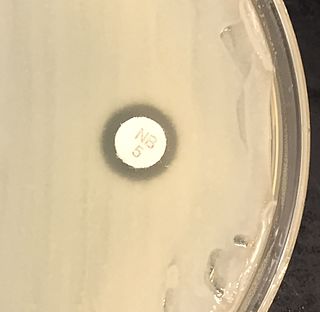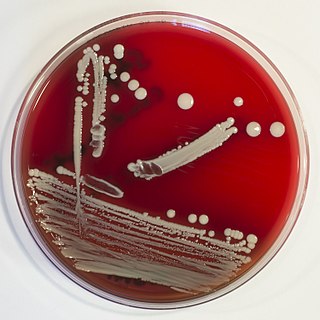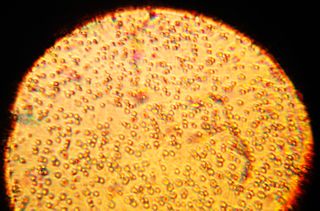
Blue cheese or bleu cheese is cheese made with cultures of the mold Penicillium, giving it spots or veins of the mold throughout the cheese, which can vary in color through various shades of blue and green. This carries a distinct smell, either from that or various specially cultivated bacteria. Some blue cheeses are injected with spores before the curds form, and others have spores mixed in with the curds after they form. Blue cheeses are typically aged in a temperature-controlled environment such as a cave. Blue cheese can be eaten by itself or can be spread, crumbled or melted into or over a range of other foods.

Staphylococcus haemolyticus is a member of the coagulase-negative staphylococci (CoNS). It is part of the skin flora of humans, and its largest populations are usually found at the axillae, perineum, and inguinal areas. S. haemolyticus also colonizes primates and domestic animals. It is a well-known opportunistic pathogen, and is the second-most frequently isolated CoNS. Infections can be localized or systemic, and are often associated with the insertion of medical devices. The highly antibiotic-resistant phenotype and ability to form biofilms make S. haemolyticus a difficult pathogen to treat. Its most closely-related species if Staphylococcus borealis.

Staphylococcus saprophyticus is a Gram-positive coccus belonging to the genus Staphylococcus. S. saprophyticus is a common cause of community-acquired urinary tract infections.
Staphylococcus caprae is a Gram-positive, coccus bacteria and a member of the genus Staphylococcus. S. caprae is coagulase-negative. It was originally isolated from goats, but members of this species have also been isolated from human samples.
Staphylococcus xylosus is a species of bacteria belonging to the genus Staphylococcus. It is a Gram-positive bacterium that forms clusters of cells. Like most staphylococcal species, it is coagulase-negative and exists as a commensal on the skin of humans and animals and in the environment.

Brucella melitensis is a Gram-negative coccobacillus bacterium from the Brucellaceae family. The bacterium causes ovine brucellosis, along with Brucella ovis. It affects primarily sheep and goats, but cases have also been observed in cattle, yaks, water buffalo, Bactrian and dromedary camels, alpacas, dogs, horses and pigs. Humans can become infected if they have contact with an infected animal or its byproducts. Animals acquire B. melitensis by venereal transmission and contact with the placenta, fetus, fetal fluids, and vaginal discharges from infected animals. The organism is found in blood, urine, milk, and semen. It is zoonotic, unlike B. ovis, causing Malta fever or localized brucellosis in humans.

Staphylococcus epidermidis is a Gram-positive bacterium, and one of over 40 species belonging to the genus Staphylococcus. It is part of the normal human flora, typically the skin flora, and less commonly the mucosal flora and also found in marine sponges. It is a facultative anaerobic bacteria. Although S. epidermidis is not usually pathogenic, patients with compromised immune systems are at risk of developing infection. These infections are generally hospital-acquired. S. epidermidis is a particular concern for people with catheters or other surgical implants because it is known to form biofilms that grow on these devices. Being part of the normal skin flora, S. epidermidis is a frequent contaminant of specimens sent to the diagnostic laboratory.
Xynotyri is an unpasteurized whey cheese from Greece made from sheep's milk or goat's milk, with a hard and flaky consistency, a pungent aroma and a yogurt-like sweet and sour taste. "Xynotyri" means "sour cheese" in Greek. Traditionally, the cheese is drained and cured in reed baskets or allowed to mature in bags made of animal skin. Cow's milk is not utilized in the production.
Staphylococcus pettenkoferi is a bacterium. Named in honour of Max von Pettenkofer, 1818–1901, German pioneer in the field of hygiene and public health, it was described in 2007 and is a member of the bacterial genus Staphylococcus, consisting of spherical, Gram-positive, nonmotile, non-spore-forming, facultative anaerobic bacteria. It is coagulase-negative and is probably a commensal organism on the skin of humans.

Staphylococcus is a genus of Gram-positive bacteria in the family Staphylococcaceae from the order Bacillales. Under the microscope, they appear spherical (cocci), and form in grape-like clusters. Staphylococcus species are facultative anaerobic organisms.
Macrococcus is a genus of Gram-positive cocci belonging to the family Staphylococcaceae. The genus was created in 1998.
Staphylococcus nepalensis is a Gram-positive coccoid bacterium belonging to the genus Staphylococcus.
Staphylococcus succinus is a Gram-positive coccoid bacterium belonging to the genus Staphylococcus.

Staphylococcus condimenti is a Gram-positive, coagulase-negative member of the bacterial genus Staphylococcus consisting of single, paired, and clustered cocci. Strains of this species were originally isolated from fermenting soy sauce mash and are positive for catalase, urease, arginine dihydrolase, nitrate reductase, beta-galactosidase, and phosphatase activity.
Staphylococcus arlettae is a gram-positive, coagulase-negative member of the bacterial genus Staphylococcus consisting of clustered cocci. It has been isolated from the skin of mammals and birds and is novobiocin resistant. A strain of this species isolated from effluent from a textile factory was found to be able to degrade azo dyes.
Staphylococcus equorum is a gram-positive, coagulase-negative member of the bacterial genus Staphylococcus consisting of clustered cocci. Originally isolated from the skin of healthy horses, this species contains a cell wall similar to that of Staphylococcus xylosus.
Staphylococcus devriesei is a Gram-positive, coagulase-negative member of the bacterial genus Staphylococcus consisting of clustered cocci. It was originally isolated from cow's milk and teats, and on the basis of 16S ribosomal RNA sequence, is most genetically similar to S. haemolyticus, S. hominis, and S. lugdunensis. More recent studies have found the species on cow teat skin, but not commonly in milk, suggesting this commensal bacterium does not generally flow into milk.
Staphylococcus intermedius is a Gram-positive, catalase positive member of the bacterial genus Staphylococcus consisting of clustered cocci. Strains of this species were originally isolated from the anterior nares of pigeons, dogs, cats, mink, and horses. Many of the isolated strains show coagulase activity. Clinical tests for detection of methicillin-resistant S. aureus may produce false positives by detecting S. intermedius, as this species shares some phenotypic traits with methicillin-resistant S. aureus strains. It has been theorized that S. intermedius has previously been misidentified as S. aureus in human dog bite wound infections, which is why molecular technologies such as MALDI-TOF and PCR are preferred in modern veterinary clinical microbiology laboratories for their more accurate identifications over biochemical tests. S. intermedius is largely phenotypically indiscriminate from Staphylococcus pseudintermedius and Staphylococcus delphini, and therefore the three organisms are considered to be included in the more general 'Staphylococcus intermedius group'.
Staphylococcus agnetis is a Gram positive, coagulase-variable member of the bacterial genus Staphylococcus. Strains of this species were originally isolated from the milk and teats of cows with mastitis. This species is not known to infect humans.

The human milk microbiota, also known as human milk probiotics (HMP), refers to the microbiota residing in the human mammary glands and breast milk. Human breast milk has been traditionally assumed to be sterile, but more recently both microbial culture and culture-independent techniques have confirmed that human milk contains diverse communities of bacteria which are distinct from other microbial communities inhabiting the human body.







